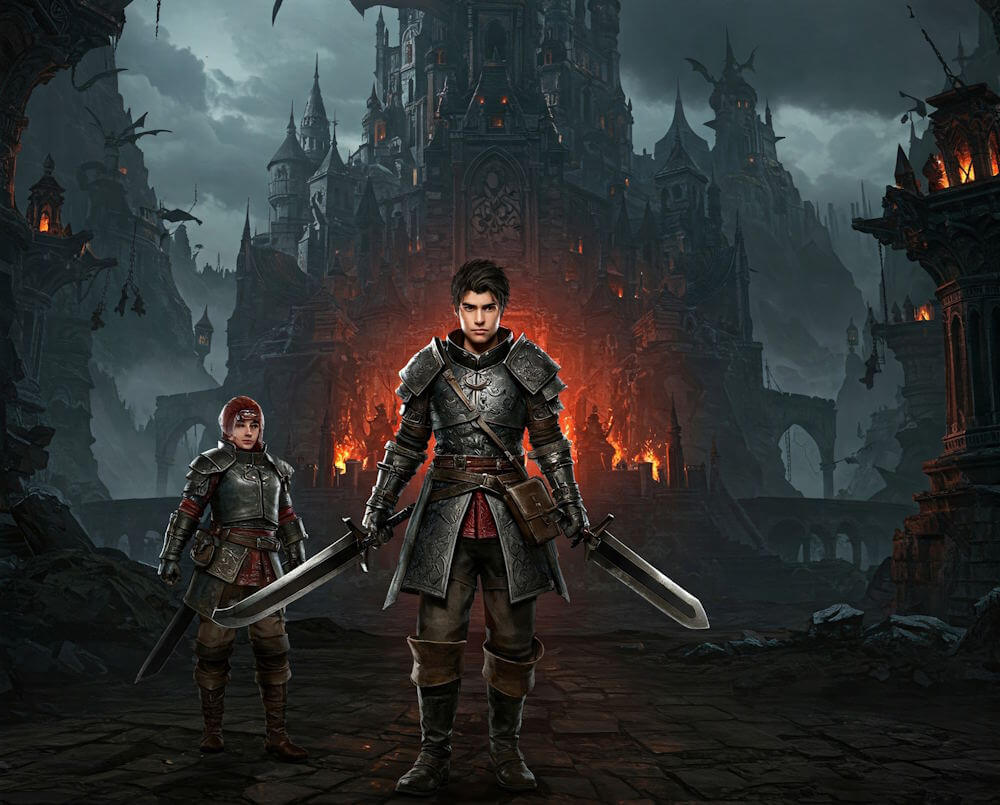Dragon’s Dogma 2 emerges as the highly anticipated sequel to Capcom’s original title, which ingrained itself in the hearts of fans with its intricate world and gripping gameplay mechanics. This new installment builds upon the legacy of its predecessor, taking players back to the enchanting yet perilous land of Gransys. The game transports players to a richly crafted fantasy realm, filled with mythical creatures, diverse locales, and a multitude of quests that promise to engage players in a deep narrative experience.
Set against the backdrop of an epic struggle between light and darkness, Dragon’s Dogma 2 extends its exploration of themes such as loyalty, sacrifice, and the human condition. Players will once again take on the role of the Arisen, who must confront formidable foes and uncover the secrets that lie within the world. The narrative intricacies are enhanced by the introduction of new characters, each contributing to a robust storyline that encourages players to forge their own path in a dynamic environment.
One of the standout features of Dragon’s Dogma 2 is its elaborate combat system, which blends action and strategy to create exhilarating encounters. Players can experiment with various classes, utilizing unique skills and abilities to thwart their enemies. The game’s companion system, which proved to be a highlight in the original, has been refined, allowing for deeper interactions and more meaningful partnerships as players navigate this expansive world.
As the gaming community eagerly awaits its release, the excitement surrounding Dragon’s Dogma 2 is palpable. With promises to elevate the experience established by its predecessor, it sets the stage for an immersive fantasy adventure that aims to captivate both returning players and newcomers alike. This review will delve deeper into gameplay mechanics, graphics, and other aspects that shape this sequel into what might become a new classic in the action RPG genre.
Graphics and Visual Design
Dragon’s Dogma 2 showcases exceptional visual artistry that significantly enhances the gaming experience. The graphic quality is markedly impressive, utilizing state-of-the-art rendering techniques to create a vibrant and immersive world. Each environment is brimming with detail, from the lush landscapes filled with towering trees and intricate foliage to the meticulously crafted architecture of towns and dungeons. The lighting effects are equally noteworthy, adding depth and realism to every scene. Dynamic weather and shifting day-night cycles contribute further to an atmosphere that feels alive, drawing players into the fantasy realm.
The art style of Dragon’s Dogma 2 strikes a balance between realism and a stylized aesthetic, creating a unique visual identity that sets it apart from many contemporary fantasy games. Character designs are distinct and memorable, with a diverse range of appearances that reflect various backgrounds and roles within the game’s universe. The ability to customize character features enhances player engagement, allowing for a personalized connection to heroes within their journey. Every character, from the grizzled warrior to the elegant mage, is brought to life through detailed textures and smooth animations that aid in unmasking the personalities behind them.
Environmental aesthetics play a crucial role in augmenting the immersive qualities of the game. Players explore dramatic landscapes that hold both beauty and danger, meticulously designed to provoke exploration and strategic thinking during combat. In comparison to other fantasy titles released in recent years, Dragon’s Dogma 2’s visual fidelity stands as a benchmark. While the genre is saturated with vivid graphics, the harmonious blend of art style and environmental detail in this title creates an unparalleled sense of immersion, ensuring that players are continuously captivated by both the sights and the stories they encounter.
Combat Mechanics and Gameplay
The combat mechanics in Dragon’s Dogma 2 are designed to offer players a dynamic and engaging experience, reflective of the game’s high fantasy setting. One of the most striking features of the gameplay is the vast array of weapons players can choose from, each offering unique abilities and combat styles. Whether wielding a sword, bow, or staff, the flexibility allows players to tailor their approach to various encounters. This diversification encourages experimentation and fosters a personal connection to gameplay, as each weapon type provides distinct advantages and disadvantages.
Building on this foundation, Dragon’s Dogma 2 introduces an in-depth skill tree system that enhances character development. Players can customize their characters to fit their preferred play styles through specialized skills and abilities. These skill trees are crucial, providing options that cater to offensive power, defensive tactics, and even magical prowess. Such depth encourages strategic decision-making, allowing players to create well-rounded characters or specialize in particular combat roles. The interaction between skills and combat strategies forms a critical component of gameplay, as players must continually adapt and refine their approach based on the complexities of each battle.
Moreover, a vital aspect of the gaming experience in Dragon’s Dogma 2 is the balance between player-controlled actions and interactions with AI companions. While players directly control their characters, the game’s intelligent AI companions, known as Pawns, contribute significantly to battles. These AI partners can be equipped with skills and weapons, serving various roles, such as healing or tanking. The synergy between player choices and Pawn behavior enriches combat, creating a more immersive environment where tactical coordination can lead to victory or defeat. The overall combat system in Dragon’s Dogma 2 thus reflects a meticulously crafted blend of variety, depth, and player agency, truly setting the stage for exhilarating encounters.
The Class System and Character Customization
In Dragon’s Dogma 2, the class system stands out as a critical element that enhances the gameplay experience, offering players a myriad of vocations that cater to diverse playstyles. Each vocation presents unique abilities and combat mechanics, allowing players to tailor their characters according to personal preferences. The primary classes are divided into three main categories: Fighter, Mage, and Strider. Fighters excel in melee combat with superior defense and prowess in close quarters, while Mages utilize powerful spells to control the battlefield and support allies. Striders are agile and adept at ranged attacks, offering a hybrid style that balances speed and precision.
Each vocation carries specialized skills that can be further developed, enabling an intricate depth of combat strategies. This versatility provides players the opportunity to experiment with various class combinations throughout their journey. For instance, transitioning from a Knight to a Sorcerer allows for a blend of melee fighting with powerful spell-casting, resulting in a unique gameplay style. The incorporation of a secondary class system introduces hybrid vocations, which further enrich the tactical options available, making every encounter different.
Character customization goes beyond mere aesthetics in Dragon’s Dogma 2. Players can modify their hero or heroine’s physical appearance, including features like hair, skin tone, and body type. This visual personalization not only creates a unique identity but also influences gameplay. The chosen class can significantly impact how a character looks, emphasizing specific attributes that reflect their role in combat. Players also have the opportunity to tailor their skills and playstyle through a skill tree system, allowing for strategic development as they progress. Overall, the class system and character customization in Dragon’s Dogma 2 offer players a rich framework to create and evolve their characters, ensuring each adventure is distinct and engaging.
Quest Design and World Exploration
The quest design in Dragon’s Dogma 2 exemplifies a seamless integration of narrative and gameplay mechanics, enhancing the overall experience for players. Unlike many conventional RPGs, quests in this title are intricately woven into the game world, allowing players to engage with the environment in meaningful ways. The game’s structure encourages exploration, with each task unfolding a bit more of the rich lore, creating an intricate tapestry of stories that enrich the player’s journey.
One of the notable aspects of the quest system is the impact of player choices. Decisions made during quests can lead to diverse outcomes, altering the game’s narrative flow and influencing character relationships. This dynamic approach not only fosters a sense of agency but also reinforces the significance of exploration. Players are incentivized to thoroughly investigate their surroundings in order to uncover hidden quests and alternative consequences that can arise from seemingly minor decisions. This interactivity infuses each playthrough with a fresh sense of excitement and discovery.
Further enhancing the experience is the open-world design that acutely reflects the complexity of the environments players traverse. Vast landscapes filled with varied biomes transform exploration into an exhilarating journey. Each region boasts unique flora, fauna, and mysteries waiting to be uncovered. From treacherous mountains to lush forests, the world of Dragon’s Dogma 2 compels players to venture off the beaten path. This allows for unexpected encounters and the opportunity to discover hidden lore that can deepen one’s understanding of the overarching narrative.
Incorporating both structured quests and the allure of open-world exploration, Dragon’s Dogma 2 successfully captivates players. The thoughtful quest design enhances engagement, while the expansive landscapes invite adventurers to delve deeper into this fantastical realm.
AI Companions and the Pawn System
One of the standout features in Dragon’s Dogma 2 is the innovative Pawn system, where players can create AI companions known as Pawns. This system significantly enhances the gameplay experience, allowing players to customize their Pawns with various skills, appearances, and traits. Each player’s Pawn can be tailored to complement their unique play style, effectively creating a personalized gaming experience. Players can allocate a variety of skills, from powerful attacks to supportive abilities, ensuring that their AI companions are well-equipped for different scenarios encountered during their journey.
The Pawn system provides a dynamic element to combat, as these AI companions are designed to learn from the player’s actions and adapt accordingly. As players engage in battles and explore the world, their Pawns observe their strategies and make tactical adjustments. For instance, if a player tends to favor ranged attacks, their Pawn might prioritize defensive maneuvers or enhance melee skills to protect the player from threats. This adaptability not only enriches the combat experience but also fosters a sense of teamwork between the player and their Pawns, making each encounter more engaging and responsive.
Moreover, the ability to share Pawns online adds another layer to the system’s depth. Players can upload their custom Pawns to a shared database, where other players can recruit them for their own adventures. This offline and online interaction creates a vibrant community where players can trade tips and strategies based on the diverse skills their Pawns bring to different gameplay styles. The Pawn system ultimately serves as a bridge between individual play and community collaboration, enhancing player engagement and leading to a richer gaming experience in Dragon’s Dogma 2.
Audio Design and Soundtrack
The audio design in Dragon’s Dogma 2 plays a crucial role in creating an immersive gaming experience, encompassing various elements such as voice acting, environmental sounds, and the musical score. From the onset, players are greeted with a rich tapestry of sound that enhances the overall ambiance of the game world. The voice acting is notably compelling, contributing depth to character interactions and narrative storytelling. Each voice actor delivers performances that resonate with the game’s tone, making the characters feel more alive and relatable.
Environmental sounds further enhance immersion, allowing players to fully engage with the vibrant landscapes of Dragon’s Dogma 2. The subtleties of rustling leaves, distant animal calls, and the echo of footsteps across cobblestones create a sense of presence and realism that is vital in fantasy RPGs. These auditory elements not only provide contextual awareness but also serve to heighten the tension during exploration and battles. For instance, the sound of an approaching dragon can instill both fear and excitement, setting the stage for epic encounters.
The musical score complements these audio elements, weaving orchestral themes that underscore the grandiose nature of the game. Garbed in an enchanting sound palette, each track is meticulously designed to enhance emotional moments, from triumphant victories to harrowing defeats. The transitions between scores seamlessly match the shifting dynamics of gameplay, creating a cohesive experience that few other RPGs can replicate.
Compared to the audio design in other role-playing games, Dragon’s Dogma 2 sets a high standard, expertly blending voice performances, sound effects, and music to elevate the player’s experience. This holistic approach to audio ensures that players remain engaged, navigating the world with an acute awareness of the sounds that surround them, thus solidifying its position in the realm of immersive fantasy combat.
Community and Player Reception
The initial reception of Dragon’s Dogma 2 has been marked by enthusiasm and anticipation from both players and critics alike. Released as a sequel to the beloved original title, the game quickly garnered attention across various platforms and forums within the gaming community. Feedback has predominantly centered around the game’s graphics, combat mechanics, and immersive world, elements that have resonated with fans of the fantasy RPG genre.
Early reviews have praised the enhanced visual fidelity and the expansive environments available for exploration. Players have expressed gratitude for the developers’ meticulous attention to detail, which has allowed for a richer storytelling experience. The combat system, a hallmark of the first installment, has undergone significant refinement; many players appreciate the fluidity of the action and its responsiveness, making battles engaging and strategic.
User-generated content, in the form of forums and social media discussions, reveals a general sentiment of excitement paired with some caution. While players celebrate the improvements, some are also voicing concerns about potential balance issues and the game’s overall depth compared to its predecessor. Community feedback highlights a desire for the game to maintain the unique elements that defined the original Dragon’s Dogma, particularly the Pawn system, which allows players to create and share custom allies.
The reception appears to be further influenced by the diverse range of fan art and gameplay videos circulating online, showcasing the game’s art style and mechanics. These discussions contribute to an evolving dialogue, enabling the community to engage with the game in a collective fashion. As players delve deeper into Dragon’s Dogma 2, the overall consensus appears to lean towards optimism, with many eagerly anticipating how the game will unfold in their own gaming journeys.
Conclusion and Final Thoughts
In concluding this review of Dragon’s Dogma 2, it is essential to reflect on the various elements that make this game a significant installment in the fantasy action RPG genre. Building upon the success of its predecessor, Dragon’s Dogma 2 successfully enhances its combat system, incorporating more dynamic gameplay mechanics and richer world-building. Players can expect to be immersed in an expansive fantasy realm that not only offers visually stunning environments but also a host of engaging quests and challenges.
One of the standout features of Dragon’s Dogma 2 is its refined combat, which emphasizes strategy and skill. The engaging combat mechanics are designed to be both accessible to newcomers and satisfying for veterans, offering multiple playstyles through different character classes. The integration of teamwork, particularly through the game’s recruitable NPCs known as pawns, adds depth to the combat and enhances the overall experience. This collaborative approach to gameplay encourages players to experiment with various tactics tailored to their specific challenges.
Furthermore, the world of Dragon’s Dogma is rich with lore and diverse ecosystems, providing players with a sense of adventure and discovery. The expansive map, populated with various creatures and hidden treasures, invites exploration and makes each journey feel meaningful. As a result, players can anticipate sustained engagement over time, as the game is structured to offer long-term enjoyment through its compelling narrative and evolving gameplay challenges.
Ultimately, Dragon’s Dogma 2 lives up to the high expectations set by its predecessor by delivering a captivating blend of fantasy combat and exploration. For those investing their time and resources into this sequel, the game promises an enriching experience that encapsulates the essence of what makes fantasy RPGs so appealing. Whether your focus is on mastering combat, venturing through a beautifully crafted world, or unraveling its intricate storylines, Dragon’s Dogma 2 is poised to become a defining title in the genre.



